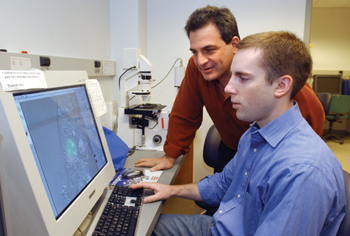
Ron Emeson, Ph.D., looks at a fluorescent image of the editor protein with Chris Sansam, a graduate student in Emeson’s lab. Dana Johnson
Molecular editor commutes to work
Just as newspaper and magazine editors change words here and there to shape story content, molecular editors finesse the protein content of cells. By changing single nucleotide “letters” in RNA, the copy of DNA that gets decoded to make proteins, the editors can dramatically alter protein — and therefore cellular — function. Disruptions of the editorial process may underlie seizures, psychiatric disorders like schizophrenia and depression, and even obesity.
Vanderbilt University Medical Center investigators studying a molecular editor, called ADAR2, have now discovered that the protein moves between two nuclear compartments to do its job. They suggest, in a report published Nov. 25 in the Proceedings of the National Academy of Sciences, that this shuttling is a way to regulate the editing activity.
“We think of it as ADAR2 commuting to work,” said Ronald B. Emeson, Ph.D., Joel G. Hardman Associate Professor of Pharmacology and Molecular Physiology & Biophysics. “ADAR2 doesn’t live in the same place that it works.”
The finding was a surprise, Emeson said. “Generally when we look at the subcellular distribution of proteins, we assume that where they are found at the greatest concentration is where they’re doing their jobs. In this case that’s not true.”
The investigators found that ADAR2 is concentrated in a specialized domain of the nucleus called the nucleolus. They demonstrated that ADAR2 shuttles between the nucleolus and the body of the nucleus, where it performs its editing function. Forcing more ADAR2 into the nucleus by disrupting its residence in the nucleolus resulted in increased editing.
“We propose that ADAR2 is being sequestered in the nucleolus until it’s needed, so that it can’t over-edit or modify RNAs inappropriately,” Emeson said. Having too much ADAR2 around will theoretically have “deleterious consequences,” he said, though the exact nature of such consequences is unknown. Other studies in the laboratory are hinting that mice with too much ADAR2 become morbidly obese.
If further experiments bear out these findings, Emeson said, “the obvious question is whether or not there are people that are obese because they have inappropriate regulation of ADAR2 levels.”
The current studies, Emeson points out, are one step toward understanding the regulation of RNA editing, which is a relatively recent scientific discovery in mammals. Editing is clearly important — knockout mice lacking the ADAR2 enzyme die shortly after birth from epileptic seizures, but RNA editing has not yet been linked to human diseases or disorders.
About 30 RNA messages are known to undergo editing of the kind studied by Emeson and colleagues — one of multiple types of RNA editing. They are predominantly neurotransmitter receptors, mostly ion channels, he said.
“We don’t know if these 30 edited RNAs are the vast majority, or if they’re just the tip of the iceberg in terms of RNA editing,” Emeson said. His laboratory is using a bioinformatic approach to compare genomic DNA sequences with message sequences, to search for additional editing events.
Christopher L. Sansam, a graduate student in Emeson’s laboratory, is the first author of the PNAS paper. K. Sam Wells, Ph.D., managing director of the Cell Imaging Shared Resource, also contributed to the studies. The research was supported by the National Institutes of Health.













